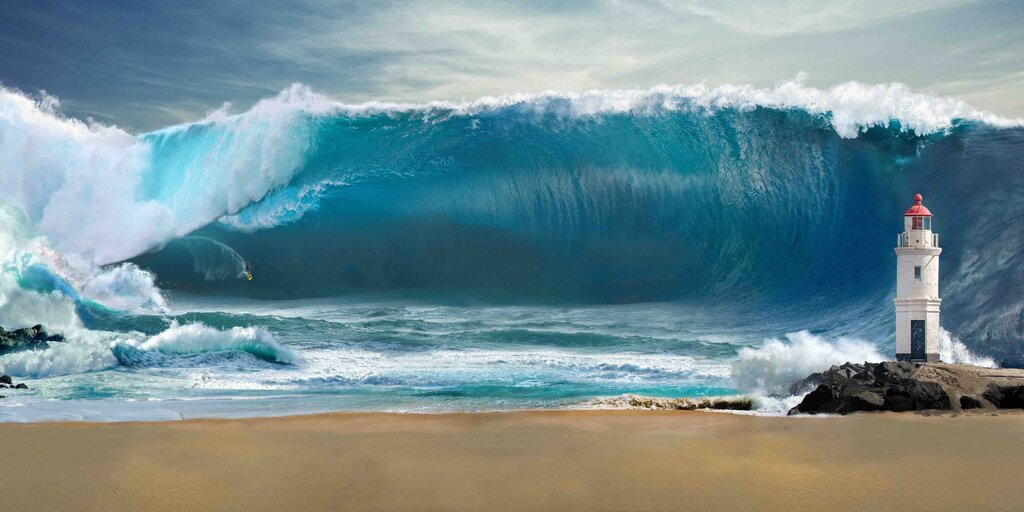
Waves are an integral part of the natural world, yet their complexity and ubiquity often go unnoticed. Whether gently lapping against the shore or towering over a surfer, waves represent a fundamental aspect of physics and geography. In this comprehensive exploration, we will delve into 20 facts about waves, revealing the intricate science and stunning beauty of these natural phenomena.
What Are Waves?
Waves are essentially a form of energy transfer. They can originate from various sources, including wind, earthquakes, or even a thrown pebble. The energy from these actions creates disturbances or oscillations, which then propagate as waves.
Different Categories of Waves
There are two main categories of waves: mechanical and electromagnetic. Mechanical waves, such as sound waves or ocean waves, require a medium like air, water, or solid matter to travel. Electromagnetic waves, on the other hand, such as light, X-rays, and radio waves, can travel through the vacuum of space.
Waves Have Distinct Properties
Each wave is characterized by its wavelength, frequency, speed, and amplitude. Wavelength is the distance between two similar points on successive waves, frequency is the number of waves passing a point per second, speed is the rate at which the wave propagates, and amplitude is the wave’s maximum displacement from its rest position.
The Sound of Music
The waves produced by musical instruments are called sound waves. Each instrument creates waves with unique wavelengths, frequencies, and amplitudes, producing distinct pitches and volumes. This diversity enables the rich variety of sounds we enjoy in music.

Light: An Electromagnetic Wave
Light, essential for life on Earth, is an electromagnetic wave. It carries energy from the sun to our planet, allowing photosynthesis to occur and enabling us to see the world around us.
Heat Waves: More Than Just Hot Weather
Heat waves, periods of excessively hot weather, are a product of high-pressure systems trapping warm air in an area. These can have severe impacts on human health and agriculture, highlighting the importance of understanding and predicting these meteorological events.
The Phenomenon of Wave Interference
When two or more waves meet, they can interact in a process known as wave interference. This can result in either constructive interference, where waves combine to create a wave of larger amplitude, or destructive interference, where waves cancel each other out.
Microwaves in Communication
Microwaves, a type of electromagnetic wave, are used in various forms of communication technology. From television and radio broadcasting to mobile phone networks and satellite communication, microwaves help us stay connected.
Tides: The Gravitational Waves
Tides are the regular rise and fall of sea levels, primarily caused by the gravitational pull of the moon and the sun on Earth’s water. These tidal waves influence marine life, coastal ecosystems, and human activities.
The Power of Tsunamis
Tsunamis, or seismic sea waves, are generated by underwater earthquakes or volcanic eruptions. These waves can travel at high speeds and build up to enormous heights as they approach the shore, causing widespread destruction.

The Magic of Standing Waves
In certain conditions, waves can combine to form standing waves, appearing to vibrate in place without any forward motion. You can observe this phenomenon in a plucked guitar string or within a resonating glass of wine.
Radio Waves: A Revolution in Communication
Radio waves, another type of electromagnetic wave, revolutionized communication when they were first harnessed for radio broadcasts in the late 19th century. They continue to play a crucial role in various technologies, including television and radar.
Infrasound and Ultrasound
Waves can also exist outside the limits of human perception. Infrasound waves have frequencies below the human hearing range, while ultrasound waves have frequencies above it. These waves are used in various applications, from monitoring volcanic activity (infrasound) to medical imaging (ultrasound).
Gravity Waves and Ripples in Space-Time
Gravity waves, not to be confused with gravitational waves, are atmospheric waves driven by buoyancy forces. On the other hand, gravitational waves, predicted by Einstein’s theory of general relativity, are ripples in space-time caused by powerful cosmic events.
The Impact of Wind on Waves
Wind plays a significant role in the creation and size of surface waves on water. The speed, duration, and distance (or “fetch”) over which the wind blows can influence wave height and power.

Colorful World Through Light Waves
Different colors result from the different wavelengths of light waves. When light strikes an object, certain wavelengths are absorbed, while others are reflected. The color we perceive is the color of the light that is reflected.
The Speed of Waves
The speed of a wave can vary depending on its type and the medium it’s traveling through. For instance, sound travels faster through solids than through air, while light travels faster in a vacuum than in water or glass.
The Lifesaving Role of Seismic Waves
Seismic waves generated by earthquakes are studied by seismologists to learn more about Earth’s interior structure. This information is crucial for predicting and mitigating the impacts of future earthquakes.
The Longest Waves: Rossby Waves
Rossby waves are a natural phenomenon in the atmosphere and oceans, caused by the rotation of the planet. These waves are hundreds or even thousands of kilometers long, influencing weather and climate.
Waves in the Quantum World
Quantum mechanics introduces the concept of matter waves or wave-particle duality. Here, particles like electrons display both wave and particle characteristics, revealing the fundamentally strange and wonderful nature of the quantum world.
Final Word
Whether on the shores of an ocean or in the invisible realms of electromagnetism and quantum physics, waves shape our world in profound ways. These 20 facts about waves offer a glimpse into their fascinating nature, illuminating the science behind the rhythms of the universe. As we continue to explore and understand these phenomena, we unlock deeper insights into the interconnected dance of energy and matter that creates the cosmos.
Was this page helpful?
Our commitment to delivering trustworthy and engaging content is at the heart of what we do. Each fact on our site is contributed by real users like you, bringing a wealth of diverse insights and information. To ensure the highest standards of accuracy and reliability, our dedicated editors meticulously review each submission. This process guarantees that the facts we share are not only fascinating but also credible. Trust in our commitment to quality and authenticity as you explore and learn with us.
